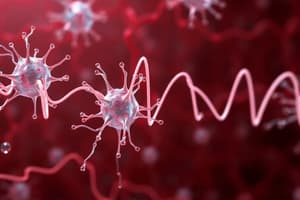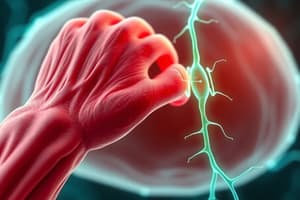Podcast
Questions and Answers
During muscle contraction, what role does calcium play in the interaction between troponin and tropomyosin?
During muscle contraction, what role does calcium play in the interaction between troponin and tropomyosin?
- Calcium binds to myosin, increasing its affinity for actin.
- Calcium binds to tropomyosin, directly exposing the myosin-binding sites on actin.
- Calcium binds to actin, causing a conformational change that allows myosin to bind.
- Calcium binds to troponin, causing a shift in tropomyosin that exposes myosin-binding sites on actin. (correct)
What is the immediate effect of ATP hydrolysis on the myosin head during muscle contraction?
What is the immediate effect of ATP hydrolysis on the myosin head during muscle contraction?
- It allows myosin to bind tightly to actin.
- It cocks the myosin head into a high-energy position. (correct)
- It provides the energy for the myosin head to detach from actin.
- It directly causes the power stroke, pulling the actin filament.
What event is directly triggered by the release of inorganic phosphate from the myosin head?
What event is directly triggered by the release of inorganic phosphate from the myosin head?
- The hydrolysis of ATP into ADP and inorganic phosphate.
- The binding of the myosin head to the actin filament.
- The detachment of the myosin head from the actin filament.
- The power stroke, causing the actin filament to slide. (correct)
What is the role of ATP in the detachment of the myosin head from the actin filament?
What is the role of ATP in the detachment of the myosin head from the actin filament?
During muscle contraction, which band's width remains unchanged?
During muscle contraction, which band's width remains unchanged?
What happens to the H zone during muscle contraction, and why?
What happens to the H zone during muscle contraction, and why?
How does the length of the I band change during muscle contraction, and what causes this change?
How does the length of the I band change during muscle contraction, and what causes this change?
What is the function of T-tubules in muscle contraction?
What is the function of T-tubules in muscle contraction?
What is the role of the dihydropyridine receptor (DHPR) in excitation-contraction coupling?
What is the role of the dihydropyridine receptor (DHPR) in excitation-contraction coupling?
How do action potentials lead to the release of calcium from the sarcoplasmic reticulum?
How do action potentials lead to the release of calcium from the sarcoplasmic reticulum?
What would happen if the ryanodine receptors were blocked?
What would happen if the ryanodine receptors were blocked?
What is the role of calsequestrin within the sarcoplasmic reticulum?
What is the role of calsequestrin within the sarcoplasmic reticulum?
What is the function of acetylcholinesterase (AChE) at the neuromuscular junction?
What is the function of acetylcholinesterase (AChE) at the neuromuscular junction?
During the excitation-contraction coupling process, what directly follows the binding of acetylcholine to nicotinic receptors on the motor end plate?
During the excitation-contraction coupling process, what directly follows the binding of acetylcholine to nicotinic receptors on the motor end plate?
Which of the following events occurs first as a result of an action potential reaching the axon terminal of a motor neuron?
Which of the following events occurs first as a result of an action potential reaching the axon terminal of a motor neuron?
Flashcards
Depolarization Cause
Depolarization Cause
Action potentials moving down the axon cause depolarization via voltage-gated sodium channels.
Calcium's Role
Calcium's Role
Calcium binds Synaptotagmin, linking V-SNAREs and T-SNAREs, pulling vesicles to the membrane for neurotransmitter release.
Acetylcholine Action
Acetylcholine Action
Acetylcholine diffuses across the synaptic cleft and binds to nicotinic receptors on the muscle cell membrane.
End-Plate Potential (EPP)
End-Plate Potential (EPP)
Signup and view all the flashcards
Activation Gate Function
Activation Gate Function
Signup and view all the flashcards
Inactivation Gate
Inactivation Gate
Signup and view all the flashcards
T-tubule Function
T-tubule Function
Signup and view all the flashcards
Receptor Coupling
Receptor Coupling
Signup and view all the flashcards
Calsequestrin Role
Calsequestrin Role
Signup and view all the flashcards
Calcium's Contraction Trigger
Calcium's Contraction Trigger
Signup and view all the flashcards
Troponin Action
Troponin Action
Signup and view all the flashcards
Tropomyosin's Blocking Role
Tropomyosin's Blocking Role
Signup and view all the flashcards
ATP's Detachment Role
ATP's Detachment Role
Signup and view all the flashcards
Myosin 'Cocking'
Myosin 'Cocking'
Signup and view all the flashcards
Power Stroke
Power Stroke
Signup and view all the flashcards
Study Notes
Skeletal Muscle Contraction: Overview
- The notes cover skeletal muscle contraction, detailing the transmission of action potentials, the role of acetylcholine, and the release of calcium.
- The information explains the coupling of these processes with the actual contraction activity.
Action Potential Transmission
- Somatic motor neurons in the anterior/ventral grey horn of the spinal cord fire, producing action potentials that move down the axon.
- Voltage-gated sodium channels open, allowing sodium to flow in, causing a depolarizing current.
- Sodium is responsible for bringing the membrane potential to threshold.
- As positive ions flow into the cell, the inside becomes more electropositive.
Role of Calcium
- Positive charges moving across the synaptic bulb stimulate proteins responsible for bringing calcium in.
- Calcium acts as a cross-link between synap proteins (Snap 25, Syntaxin, Synaptobrevin, Synaptotagmin) which intertwine to pull the vesicle towards the plasma membrane of the synaptic bulb.
- The vesicle fuses with the plasma membrane, releasing acetylcholine into the synaptic cleft.
Acetylcholine Production and Release
- Mitochondria produce Acetyl CoA
- Choline from the diet combines with Acetyl CoA to make Acetylcholine.
- Acetylcholine is transported into synaptic vesicles, using a proton pump to concentrate protons.
- Acetylcholine diffuses across the synaptic cleft and binds to nicotinic receptors (primarily type 1) on the muscle cell membrane.
- Binding opens the channels, allowing sodium to flow in and potassium to flow out.
- More sodium ions come in than potassium ions go out, producing a small depolarization called the end plate potential (EPP).
- The EPP moves along the membrane, opening voltage-gated sodium channels.
Voltage-Gated Sodium Channels
- Activation gates are stimulated by threshold potential (approximately -55 mV) and open quickly.
- Inactivation gates are also stimulated by threshold potential but close slowly.
- Sodium flushes in until the potential reaches approximately +30 mV., at which point the inactivation gate closes.
- Positive charges move along the muscle cell membrane and depolarize the T-tubules.
T-Tubules and Sarcoplasmic Reticulum
- T-tubules are invaginations of the sarcolemma (plasma membrane) and are coupled with the sarcoplasmic reticulum.
- A triad is formed by a T-tubule with sarcoplasmic reticulum on both sides.
- The action potential moving down the T-tubule stimulates the dihydropyridine receptor, which is mechanically coupled to the ryanodine receptor type 1 on the sarcoplasmic reticulum.
- This causes the ryanodine receptor to open, releasing calcium from the sarcoplasmic reticulum.
Calcium Concentration and Release
- Calcium is highly concentrated in the sarcoplasmic reticulum due to calsequestrin.
- When ryanodine receptors are displaced, calcium leaves the sarcoplasmic reticulum and enters the sarcoplasm (the fluid part of the muscle cell containing myofibrils and mitochondria).
- This occurs at the peak point of the action potential.
Myofilaments and Contraction
- Calcium binds to the troponin C site which pulls on troponin T, which is linked to tropomyosin. This binding unblocks the active sites on actin, allowing myosin heads to bind.
- Troponin has TNC, TNT, and TNI sites where calcium binds.
- Tropomyosin blocks myosin heads from binding to actin active sites when the muscle cell is at rest. Calcium stimulus allows contraction to begin.
Myosin-Actin Interaction
- ATP binds to the myosin head, causing it to detach from actin.
- ATP is hydrolyzed into ADP and inorganic phosphate, causing the myosin head to "cock" back into a high-energy position.
- The myosin head binds to actin, and the release of inorganic phosphate initiates the power stroke, pulling the actin filament towards the M-line.
- ADP is then released, leaving myosin in an uncomfortable position.
- ATP then binds to myosin, causing it to detach from actin and start the cycle again.
- Cellular respiration (aerobic and anaerobic) provides ATP for this process.
Sarcomere Changes During Contraction
- A-band: The length of the thick filament; stays the same during contraction.
- I-band: The distance from the end of one thick filament to the thick filament on the other sarcomere; decreases during contraction as the Z discs are pulled closer.
- H-zone: The distance between thin filaments; disappears during contraction as thin filaments slide over each other.
- Z discs: Get closer to one another during contraction.
- M-line: Where myosin filaments attach.
Role of Titan
- Titan is a very elastic protein that prevents overstretching and provides structural support to the sarcomere.
- During contraction, Titan gets stretched and pulls on Z discs, bringing them closer together.
Muscle Relaxation
- Muscle relaxation is equally important, and involves voltage-sensitive potassium channels, calcium channels, sodium-calcium exchanger proteins, and proteins on the sarcoplasmic reticulum.
Studying That Suits You
Use AI to generate personalized quizzes and flashcards to suit your learning preferences.
Description
Explanation of skeletal muscle contraction, detailing action potential transmission, the role of acetylcholine, and calcium release. Describes their coupling with contraction activity, from somatic motor neuron firing to membrane potential changes.




